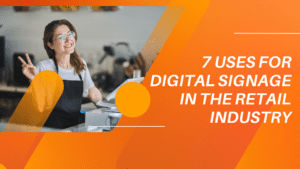
7 Uses for Digital Signage in the Retail Industry
Digital signage has changed the way people shop. It’s no longer just about getting a sale; it’s about creating an experience that will get customers to come back again and again. With digital signage, retailers can show ads, create interactive experiences, enhance customer service, and more while giving shoppers a quick fix of the information they want. Not only does this help attract new business — it also creates higher profit margins and stronger brand loyalty by keeping customers happy with their shopping experience. Read on for examples of digital signage in retail stores today!
Endless Aisle Kiosk Digital Signage
An Endless Aisle Kiosk is a digital signage solution that allows you to have a single device that can be used in multiple locations. For example, you could use the same device to display ads and promotions on your website, in-store, and even at tradeshows or conferences.
The benefits of using an Endless Aisle Kiosk include:
- It’s versatile; it can be used anywhere there’s a power outlet.
- It’s cost-effective; it requires no additional infrastructure to set up or maintain. You won’t need to hire someone with specialized knowledge of digital advertising or IT systems because they’re easy enough for anyone with basic computer experience to manage.
- You’ll save money by cutting down on the costs of purchasing several different devices (or trying one thing out and then having to change).
Digital Signage Ads
Digital signage is a great way to advertise. You can use it to show ads and information about products, events, and promotions. Your customers will respond better if they see something that interests them on digital signage rather than just having an ad thrown at them.
- Use digital signage to advertise your products
You can use this technology in retail stores or any other business where you sell products or services. Digital signs are usually placed near the area where the product is sold so that customers can easily notice it and get interested in buying what they see advertised on the screen of the sign. Digital signs are also helpful because they increase brand awareness by promoting a specific product range while showing relevant messages about each item being promoted or advertised. For example, if you have a clothing store, then you could use this type of advertising technique by displaying all different kinds of clothing options available with descriptions such as “This dress comes in red” or “This shoe costs $15,” etc., so people who walk by will know exactly what kind of items are available for sale inside your store without having to ask someone working there questions first.
Smart Dressing Rooms
How often have you been shopping and decided to try something on in the dressing room, only to find that it doesn’t fit? Or maybe you bought something online but wanted to see how it looked in person. Smart dressing rooms are a great way to improve customer satisfaction and increase sales.
Smart dressing rooms can be used to provide customers with a better shopping experience by providing:
- real-time feedback on products they are trying on (e.g., “Your size is not available.”)
- information about other products or related items that may interest them (“Shopping cart items that will look good with this dress”).
- recommendations based on their current preferences, such as what colors they tend to prefer or which styles look best on them.
Interactive Touchscreens
Retail digital signage is an easy way to engage customers and keep them entertained while they are waiting in line. For example, you can use touchscreens that allow customers to learn more about products, place orders and learn more about the store.
Touchscreen kiosks are also a great way to promote your brand and build trust with your audience. Customers feel safer when they know they are dealing with a company with a strong online presence and digital assets because this gives them confidence that their information will be secure during transactions.
Digital Menus
- Digital menus are a great way to share information about the food and drinks available at your restaurant.
- They can be used to show the daily specials or to let customers know about the ingredients in a particular dish.
- Many restaurants use digital menus to tell their story—how they got started, what makes them unique, and why they chose their current location. This helps customers feel more connected with the business and encourages them to spend more money there.
Heatmaps and Location Tracking
With the help of location tracking, you can learn more about how your customers move through their day. For example, you can track where they enter the store, where they browse and buy products, and where they leave. This information can be used in several ways:
- Improve store layout
- Improve customer service
- Improve marketing
- Improve sales
Navigation and Wayfinding Signs
Wayfinding signs are an important component of the overall retail digital signage strategy. When implemented properly, they can help customers navigate your store and find what they want. Wayfinding signs should be placed strategically throughout the store to guide customers from one destination to another.
- Traditional wayfinding signs:
- Traditional wayfinding signs provide directional guidance for shoppers as they move through your retail environment. These traditional signs will work well if you have a large physical space with many departments that need to be navigated by your customers (think grocery stores, department stores). If you have a smaller space with fewer departments or if there is less movement between areas in your store, then traditional wayfinding may not be appropriate for your needs.
With digital signage, retailers can show ads, create interactive experiences, enhance customer service, and more while giving shoppers a quick fix of the information they want.
Digital signage in retail stores can be used in many ways, from engaging customers to advertising and providing customer service. Here are seven examples of digital signage for retail:
- Customer engagement: Retailers can use digital signage to engage their customers by showing ads and new products, displaying the latest sales and deals, or offering a quick tutorial on using a product. This way, shoppers won’t have to wait around for an employee who might or might not know what they’re talking about, rather than waiting around for an employee who might not even be available at that time (or worse yet—can’t even find what they’re looking for!) shoppers can get their questions answered right away with digital signage.
- Advertising: Digital screens are ideal for advertising because they’re easily visible from far distances—making them perfect for drawing attention from passersby—and can be customized so that each screen displays different ads depending on its location within the store.
- Customer service: Using digital signs in stores helps ensure great customer service by allowing employees to provide answers quickly without leaving their posts behind cash registers or elsewhere throughout stores. With interactive touchscreens connected directly to inventory systems and point-of-sale terminals where shoppers can browse through product details as well as pricing information before making purchases online via mobile phones after checking out items in person first!
Digital signage can be used to create a more engaging shopping experience, which will ultimately bring more customers into the store. Retailers should consider all of the ways that their digital signage can benefit them and then choose the option that best fits their needs.
To learn how MCC can help your retail business with digital signage or any of our other technology solutions, request a demo.


